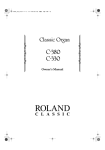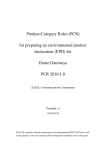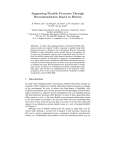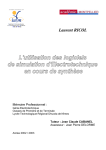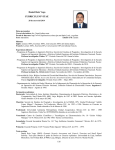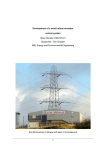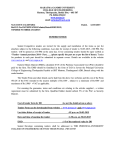Download Troubleshooting and Fixing of Inverter Driven In
Transcript
Troubleshooting and Fixing of Inverter Driven Induction Motor Bearing Currents in Existing Plants of Large Size - an Evaluation of Possible Mitigation Techniques in Practical Applications 1 S. Guttowski1, S. Weber1, M. Schinkel1, W. John1, H. Reichl2 Fraunhofer Institute for Reliability and Microintegration, Gustav-Meyer-Allee 25, 13355 Berlin, Germany 2 Berlin Center of Advanced Packaging, TIB4/2-1 Gustav-Meyer-Allee 25, 13355 Berlin, Germany Abstract – The effect of bearing currents in inverter driven induction motors has been investigated and reported for about ten years. Mitigation techniques have been developed and approved by experiments. In this paper, the special situation of troubleshooting in a given configuration such as existing large plants is discussed. The determination of the actual bearing current phenomenon and the development of the appropriate mitigation technique under given circumstances are shown. A new equivalent circuit diagram for the bearing currents in large drives has been developed and used for evaluation of mitigation techniques. Experiences applying the mitigation techniques to a drive suffering premature damages due to rotor ground bearing current are presented and discussed using experimental results. I. INTRODUCTION The application of adjustable speed drives (ASD) is increasing due to improved system efficiencies providing energy savings and ease in control. The development of advanced power electronic switching devices has enabled high frequency switching operation and has improved the performance of the pulse-width modulated (PWM) inverters of the ASD. However, the high rate of voltage rise of typical IGBT inverters has adverse effects in the form of motor insulation stress, electromagnetic interference and bearing and leakage currents caused by common mode voltages [1-6]. A high percentage of process disruptions are due to bearing failures. In the meantime a substantial number of mitigation techniques have been developed [1, 7-12]. However, the industrial user searching the literature for an immediate solution encountering a concrete bearing current problem in an existing plant configuration finds itself abandoned since most of the mitigation techniques are not feasible without enormous changes of the electrical plant configuration. This paper addresses the practical problems being told to solve a bearing current problem in an existing plant with premature bearing failures due to rotor ground currents in large adjustable speed drives. The final conclusions derived from the mitigation method evaluation can be summarized to a guideline that supports the expert responsible for the bearing current suppression in existing plant configurations as well as during system modernizations. II. BEARING CURRENT TROUBLESHOOTING Troubleshooting in existing plants of large size means firstly to determine which bearing current phenomena causes the bearing failures. Therefore, a short review of the known bearing current phenomena followed by a discussion how the actual phenomenon can be determined will be given here. A. Short Review of Bearing Currents Phenomena The different types of bearings currents have been described very well by the authors in [8]. So, at this place only a short review focusing on the specific aspects necessary for this paper will be given. The common mode voltage caused by the feeding inverter leads to currents due to the unavoidable parasitic capacities within the induction motor. In Figure 1 the allocation of these parasitic capacities within an induction motor model can be seen. Four types of bearing currents, the small capacitive currents, the electrostatic dis- Figure 1: Parasitic capacities within of an induction motor Figure 4: Equivalent circuit diagram for rotor ground currents charge currents (EDM), the circulating bearing currents and the rotor ground currents, have been explored so far. In this paper the focus lies on high power applications, so not only the small capacitive currents but also the electrostatic discharge currents (EDM) can be neglected. Circulating bearing currents are known to be caused by the high frequency current flowing from the stator to ground. As shown in Figure 2, this current excites a circular magnetic flux Φcirc, which induces an additional shaft voltage, thus causing circular bearing currents. Rotor ground currents are caused by poor grounding conditions that can be found especially in existing plants with older electrical systems. In such configurations, the rotor ground impedance may be significant lower than the grounding of the stator housing. The unavoidable common mode current, generated by the high dv/dt of the common mode voltage, flows to substantial portion through the bearings of motor via the rotor and the driven machine to ground. In Figure 3 the current paths of the rotor ground current can be seen whereas the rectangle solid on the right side in the figure shall mention the driven machine where the current is flowing through. In Figure 4 an extension of the commonly used equivalent circuit diagram for the bearing current phenomena is shown. Especially for the troubleshooting and mitigation evaluation described in this paper this extension has proofed to be very useful. In addition to the commonly used equivalent circuit diagram in this single-phase diagram the whole system has been taken into account. The power converter is represented by the common mode voltage source Vcm. The cable between the power converter and the motor has been included by the elements Rc, Lc and Ccg. The elements Rw and Lw represent the winding of the induction motor. The capacities Cwf, Cwr, Crf, Cb1 and Cb2 are the parasitic capacities within the motor as shown in Figure 1. In order to discuss the phenomenon rotor ground current the diagram has been extended by the impedances Zg,im and Zg,pm as well as the capacity Cb,pm. The impedance Zg,im, which is the impedance of the real current path from the induction motor to the ground, is the cause of current flowing through the bearings to the driven machine. The capacity Cb,pm and the impedance Zg,pm represent the currents path through the bearings of the driven machine to ground. In this diagram the two parallel paths of the common mode current from the motor frame to ground can be seen and the influence of the mitigation measures on these paths can be evaluated. The measures against the rotor ground currents have in common that the current path through the bearings of the motor and the driven machine needs to be made more unalluring so the dangerous current flows somewhere else. Figure 3: Current paths of the rotor ground currents B. Measurements for Phenomena Determination The procedure necessary to determine the kind and exact amount of current flowing through the bearings of an induction motor has been described based on the results of several research projects. Although the methods applicable to the machines especially dissected for the experiments can not be applied to the motor of the large adjustable speed drives in an existing plant being told to solve the bearing current problems. Knowing that the small capacitive currents and the electrostatic discharge currents do not appear in large induc- -U +W Φcirc +V -V -W +U Figure 2: Causes and paths for circulating bearing currents Figure 5: Investigation of rotor ground currents in existing plants tion motors the investigation can be focused on the circulating currents and the rotor ground currents. But only the rotor ground currents can be measured in existing systems. In Figure 5 the measuring points for the rotor ground current investigation can be seen. The common mode current flowing into the induction motor is determined at measuring point M1 indicates the amount of current that is flowing out of the motor at the other current terminals such as the motor grounding, the cable for the temperature monitor, the cable for the shaft encoder and of course the shaft to the driven machine. The current at measuring point M2 evaluates the effectiveness of the motor grounding which might be very helpful for explaining the current flowing through the shaft. Whereas the measuring points M1 and M2 are easily to realize the measuring point M3 can be realized only by using special Rogowski-Coil current probes since the measurements have to be taken during operation of the motor. III. MITIGATION TECHNIQUES Mitigation techniques for inverter driven bearing currents have been developed and presented by different authors. The question, underlying in this paper, focuses on the feasibility of the mitigation methods for troubleshooting being told to solve a bearing current problem in an existing plant with premature bearing failures in large adjustable speed drives. So the mitigation techniques need to be discussed in terms of their suitability for a concrete bearing current problem in an existing plant configuration. The mitigation techniques taken into account are A) Modulation scheme with low common mode voltage, B) dv/dt – Filter at the inverter output, C) Insulated bearings, D) Insulated clutch between induction motor and machine, E) Low impedance connection between induction motor and machine, F) Shielded cables between inverter and induction motor and G) Shaft grounding brush. The possibility of low resistance lubrication has been left out due to the lacking availability. A. Modulation scheme with low common mode voltage Several modulation schemes for adjustable speed drives with common mode voltage reduction have been presented. Figure 6: Equivalent circuit diagram for insulated bearings The effectiveness of those schemes has been approved by simulations and be practical experiments. From the troubleshooting point of view this approach can not be considered to be a useful mitigation since the idea of changing the modulation scheme within an existing plant is not feasible. B. dv/dt – Filter at the inverter output The effectiveness of different types of filters at the inverter output has been investigated carefully in [10]. Although filters that reduce the dv/dt of the line-to-earth voltage reduce the rotor ground currents significantly the additional integration of such filters often exceed the possibilities during troubleshooting and fixing. Furthermore in many applications the costs for additional filters between the motor and the induction motor can not be beard by the operating company. C. Insulated Bearings Insulating both bearings breaks the path for the rotor ground currents as shown in Figure 6. The implementation of one insulated bearing seems often to be the first mitigation applied to the motor since the damaged bearing needs to be changed anyway. However, this method may not be acceptable for some applications, since the shaft voltage still exists and will attempt to find a path to ground elsewhere. In many applications an electrical insulated rotor is not desired by the operating company. D. Insulated clutch between motor and machine In Figure 7 the effectiveness of an insulating clutch between the motor and the driven machine is demonstrated. Obviously the clutch opens the path for the rotor ground cur- Figure 7: Equivalent circuit diagram for insulated clutch Figure 8: Equivalent circuit for connection between motor and machine rents and the currents on the shaft can be avoided. But the integration of an insulating clutch into an existing system means significant changes not only of the electrical but also of the mechanical system parameter and is not acceptable for operating companies. E. Low impedance connection between induction motor and machine Being encountered by a rotor ground current problem to be solved the electrical connection between the induction motor and the machine seems to be very promising. As it can be seen in Figure 8 the additional path between the motor frame and the driven machine housing lays in parallel to the current path though the bearings and the shaft. This mitigation can be applied very easily and it leads to substantial improvements as long as the connection does not exceed a certain length. In several applications where other mitigations were eliminated the bearing currents could have been reduced by factor 2. The main disadvantage lies in the fact that the connection has to be maintained. F. Shielded cables between inverter and induction motor The length of the connection between the inverter and the motor has an immense impact on the risk of bearing currents. The use of shielded cables is known to reduce the rotor ground currents as well as the circulating currents [7, 8, 13]. However, the higher cost due to the shielded cables always needs to be motivated, and furthermore, shielded cables are not feasible in all applications. In Figure 9 the equivalent circuit diagram extended by the elements of the shield is shown. It has been assumed that the shield has been contacted on both the motor frame as well as the grounding point of the Figure 9: Shielded Cables as mitigation for rotor ground currents Figure 10: Shielded Cables as mitigation for rotor ground currents power converter. In order to discuss the kind of shield necessary for this mitigation the equivalent circuit has been enhanced to the model shown in Figure 10. The effectiveness of the shielded cable depends only on the magnetic coupling between the inner conductors and the shield. Due to the low frequencies that need to be handled here the use of the very Figure 11: Cable configurations for bearing current mitigation expensive EMC cable shields is not necessary. In Figure 11 the cable configurations investigated using the model shown in Figure 10 can be seen. The EMC shield, not illustrated here, has been compared to a configuration with an concentrical ground conductor and the configuration on the right side in Figure 11, the symmetrical cable. Using the finite element method the magnetic coupling between the inner conductors and the shield has been calculated and used for a simplorer circuit simulation. The results, the shield current Ish relating to the common mode current Icm at the inner conductors are shown in Figure 12. It can bee seen that even with the simplified model in Figure 10 the configuration with the con- Figure 12: Shielding effectiveness of investigated cable 40 Common Mode Current current [A] -10 15 10 5 0 -5 -10 Shaft Current current [A] 30 20 15 10 Ground Current current [A] 10 0 5 0 -5 -10 0.0 10.0µ 20.0µ 30.0µ 40.0µ 50.0µ 60.0µ time [s] Figure 13: Bearing currents – initial situation centrical ground conductor serves as a useful bearing current mitigation. G. Shaft grounding brush The application of a shaft grounding brush inserts a bypass for the currents in parallel to the bearings. But it is evident that this mitigation would protect the motor bearings only whereas the bearings in the driven machine suffer even higher currents due to the lower impedance within the induction motor. An additional disadvantage lies in the fact that the brush needs to be maintained. IV. EVALUATION OF THE MITIGATION TECHNIQUES BASED ON A PRACTICAL APPLICATION The mitigation techniques have been applied to a practical bearing current problem in a drive system of a paper mill. Two 500 kW induction motors driving a creping cylinder via a common gear have been investigated comparatively. The creping cylinder has the dimension of 5.5 x 5.95 meters and a weight of 150 tones. In both motors the bearings have had premature failures due to bearing currents identified to be rotor ground currents. 40 current [A] 20 10 0 Shaft Current 4 current [A] B. Approach 1 – improved grounding The first approach aimed at improving grounding conditions. As mentioned in the introduction, the rotor ground currents are caused mainly by poor grounding of the induction motors. In this example the induction motor is as usual in paper mills arranged at a solid concrete block and no structural grounding such as machine frame was given. The improved grounding was provided by an additional flexible wire from the motor to the grounding point of the building that is much closer than 10 m. The improved grounding has reduced the current at the shaft at MP3 by about 20 %. So, the bearing currents have shown peak values of up to 14 A, which still exceed the acceptable values significantly. C. Approach 2 – low impedance connection The mitigation described in section III.E was the second approach to reduce the bearing currents that were measurable at MP3. So an additional flexible cupper meshwork was connected between the induction motor and the frame of the paper mill. In this particular case the shaft between the motor and paper mill was fairly short, so this measure was successful. This additional wiring has reduced the remaining bearing currents by factor 2, which basically confirms the experience gained from other bearing current investigations. Common Mode Current 30 2 0 -2 Ground Current 15 current [A] A. Initial Situation – poor grounding conditions The initial situation from the viewpoint of the bearing current phenomenon was characterized by a length of the cable of 250 m and the concentrical shield of the cable was connected in such a way that the electrical conditions were corresponding to non-shielded cables. The grounding measure was effective for currents of very low frequency since the length of the grounding wire was about 10 m to the grounding point of the building. In Figure 13 the initial situation of the bearing current problem has been recorded. Peak currents of up to 17 A could be measured flowing through the bearings and the operating time for the bearings was extremely shortened. 10 5 0 -5 0.0 10.0µ 20.0µ 30.0µ 40.0µ 50.0µ time [s] Figure 14: Bearing currents – final solution 60.0µ D. Approach 3 – cable shield application The cables in this particular paper mill were designed with concentrical ground conductor but by mistake the connection with the motor was not realized according to the requirements. So, it was possible to determine the influence of the cable in a real system. Although the connection made subsequently did not reach the impedance that could had been reached by correct installed wirings. In Figure 14 the currents flowing into and out of this investigated induction motor are shown. Due to the special situation of subsequently connected shielding the common mode current could be determined separately. In systems were the concentrical grounding conductor has been installed correctly the current probes can determine only the differential current of the inner conductors and the shield. The current flowing through the bearings and the shaft between the motor and the paper mill could be reduced to about 2 A. According to the experiences gained from other bearing current investigations this is acceptable for induction motors of such size. V. DISCUSSION In this particular case the cable were prepared to electrically add the concentrical grounding conductor. So, it could be shown to which extend this measure can reduce and as the case may be avoid bearing current problems. But mostly, this will not be the case. In existing systems such as paper mills only the mitigations without any changes in the wiring harness will be acceptable. Rotor ground currents occur often when the electrical drive system in existing plants have been modernized. Depending on the electrical system in the plant before the modernization not the complete electrical systems is exchanged but for example only the power converter. Depending on the degree of modernization the following guideline for bearing current avoiding can be given. A. Exchange of the complete drive system In the case of a modernization of the whole system the safest way to avoid bearing current problems is to install cables with concentrical grounding conductor. Although the grounding conditions at the places of the motors are expected to be poor the only additional measure to be adopted is to connect the motors with the grounding point of the building. The additional costs due to the special cable are mostly acceptable compared to the avoided risk of bearing damages. B. Exchange of the power converters and wiring If only the power converter and the wiring need to be exchanged basically the same recommendation can be given as for A. But the connections of the concentrical cables at the motor terminals need to be made very carefully since the contact impedance is very important for the effectiveness of the mitigation as shown. C. Exchange of only the power converter The real challenge for the system designer occurs when only the power converters need to be changed and the wiring and the motors have to remain. In this case mostly the cables are not equipped with a shield and the other mitigations need to be considered. The first step must be to improve the grounding conditions of the induction motors. The low impedance connection between the motors and the frame of the paper mill in combination with good grounding conditions has solved many bearing current problems in the past. If these mitigations do not solve the problem additional measures such as output filters have to be considered. In either case the rotor ground currents need to be checked for each motor of the system if unexpected downtimes caused by premature damages due to bearing currents shall be avoided. VI. CONCLUSION The idea of this paper is to provide the industrial user encountering a bearing current problem in an existing plant configuration a guideline for the mitigation development applicable for the industrial practice. For this reason, the explored bearing current phenomena and the developed mitigation techniques have been reviewed. The mitigation techniques have been applied to a practical bearing current problem if a large drive. The effectiveness of the mitigation techniques has been determined by measurements. So, the appropriate mitigation technique for this specific bearing current problem could be derived. The results of this investigation have been derived from a bearing current problem of a concrete drive but, the cognitions are of general usefulness. VII. REFERENCES [1] [2] [3] [4] [5] [6] [7] [8] [9] [10] [11] [12] [13] A. von Jouanne, H. Zhang, and A. K. Wallace, "An evaluation of mitigation techniques for bearing currents, EMI and overvoltages in ASD applications," Industry Applications, IEEE Transactions on, vol. 34, pp. 1113-1122, 1998. S. Chen, T. A. Lipo, and D. W. Novotny, "Circulating type motor bearing current in inverter drives," IEEE IAS Annual Meeting, 1996. D. Busse, J. Erdman, R. J. Kerkman, D. Schlegel, and G. Skibinski, "System electrical parameters and their effects on bearing currents," Applied Power Electronics Conference and Exposition. APEC 1996. D. F. Busse, J. M. Erdman, R. J. Kerkman, D. W. Schlegel, and G. L. Skibinski, "The effects of PWM voltage source inverters on the mechanical performance of rolling bearings," Industry Applications, IEEE Transactions on, vol. 33, pp. 567-576, 1997. S. Chen, T. A. Lipo, and D. Fitzgerald, "Modeling of motor bearing currents in PWM inverter drives," Industry Applications, IEEE Transactions on, vol. 32, pp. 1365-1370, 1996. J. Erdman, R. J. Kerkman, D. Schlegel, and G. Skibinski, "Effect of PWM inverters on AC motor bearing currents and shaft voltages," Applied Power Electronics Conference and Exposition, APEC 1995. P. J. Link, "Minimizing electric bearing currents in ASD systems," Industry Applications Magazine, IEEE, vol. 5, pp. 55-66, 1999. A. Muetze and A. Binder, "Experimental evaluation of mitigation techniques for bearing currents in inverter-supplied drive-systems - investigations on induction motors up to 500 kW," International Electric Machines and Drives Conference, IEMDC 2003. J. Zitzelsberger and W. Hofmann, "Effects of modified modulation strategies on bearing currents and operational characteristics of AC induction machines," Industrial Electronics Society, 2004. A. Muetze, A. Binder, H. Vogel, and J. Hering, "Experimental evaluation of the endangerment of ball bearings due to inverter-induced bearing currents," IEEE IAS Annual Meeting, 2004. R. F. Schiferl and M. J. Melfi, "Bearing current remediation options," Industry Applications Magazine, IEEE, vol. 10, pp. 40-50, 2004. D. Hyypio, "Mitigation of bearing electro-erosion of inverter-fed motors through passive common-mode voltage suppression," Industry Applications, IEEE Transactions on, vol. 41, pp. 576-583, 2005. E. J. Bartolucci and B. H. Finke, "Cable design for PWM variablespeed AC drives," Industry Applications, IEEE Transactions on, vol. 37, pp. 415-422, 2001.






